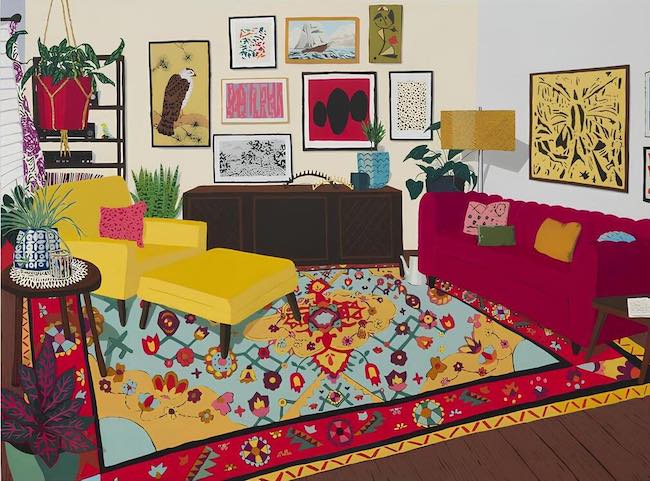Le abitudini, le tradizioni, tutto ciò che appartiene al mondo conosciuto e a volte personale e intimo, sono da sempre soggetto e oggetto di rappresentazione artistica, specialmente per quei creativi che vivono immersi nella propria realtà fatta di abitudini e certezze quotidiane, ma anche di osservazione dei luoghi e dei dettagli che li circondano. Laddove alcuni avvertono il bisogno di narrare in maniera fortemente realista tutto ciò su cui il loro sguardo si posa, altri invece preferiscono lasciarsi andare a sensazioni fanciullesche, immaginarie, ingenue, perché la loro fantasia ha bisogno di oltrepassare la realtà e immergersi nella dimensione delle emozioni, stilizzando e descrivendo ciò che vedono come se si trovassero davanti a una fiaba. L’artista di cui vi racconterò oggi sceglie uno stile già di per sé legato alla semplicità espressiva per raccontare tutto ciò che la circonda e che appartiene al suo personale vissuto.
La fine del Diciannovesimo secolo segnò l’inizio di quel processo di allontanamento dall’arte accademica destinato a rivoluzionare la storia e i gusti degli appassionati malgrado le resistenze dei circoli culturali che contavano. In particolar modo in Francia un coraggioso e visionario artista, Henri Rousseau, presentò al Salon des Indépendents la sua produzione artistica contraddistinta da un tratto pittorico stilizzato, evidentemente privo di conoscenze specifiche, attraverso il quale descriveva un mondo immaginario fatto di foreste, di belve feroci, di fitta vegetazione, di luoghi che non aveva mai visitato. Fu esattamente in quell’occasione che nacque lo stile Naïf in cui gli artisti che vi aderirono mostrarono l’inclinazione a descrivere dimensioni poetiche, immerse in una dimensione quasi magica in alcuni casi, raccontando la quotidianità con uno sguardo diverso, quello dell’innocenza. Lo stile assunse caratteristiche diverse in base al paese di appartenenza ma anche all’inclinazione del singolo artista, per cui in Europa centrale e in alcuni esponenti italiani e francesi fu contraddistinto da paesaggi visti in lontananza abitati da moltitudini di personaggi piccoli, quasi miniaturizzati, come nelle opere di Zuzana Chapulova o di Orneore Metelli e di Louis Vivin; in altri casi invece le figure erano più grandi, pur restando legate all’immediatezza e alla semplicità rappresentativa ma anche espressiva, come in parte della produzione francese, di cui fu esponente oltre a Henri Rousseau anche Camille Bambois, italiana con Antonio Ligabue, sudamericana con Fernando Botero e Tarsila do Amaral, senza dimenticare Frida Kahlo, a metà tra Naïf e Surrealismo. Parallelamente a questo tipo di rivoluzione artistica, si delineò nei primi del Novecento anche un’innovazione stilistica che nella sua evoluzione incrociò in qualche modo il suo destino a quello del Naïf poiché presentava un approccio cromatico e figurativo simile con in più il tocco irreale dato da un’interpretazione del tutto emozionale sull’osservato; il gruppo dei Fauves infatti mise il colore al centro dell’opera, come se fosse l’attore principale in grado di comunicare immediatamente all’osservatore la sensazione che l’autore dell’opera voleva esprimere. Non solo, alcuni di questi artisti, come Henri Matisse, descrivevano il loro mondo in maniera fiabesca perché in fondo la realtà quotidiana poteva essere interpretata con un punto di vista meno serioso, meno noioso, e dunque più attento a tutte quei dettagli in grado di emozionare solo per la loro costante presenza.
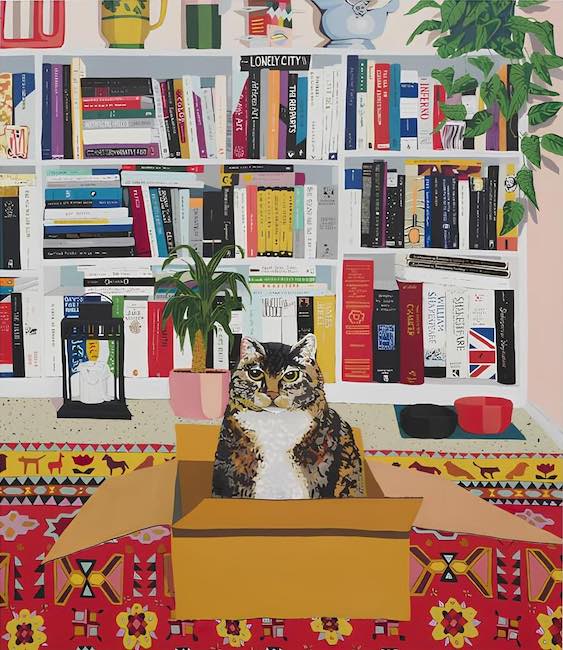
L’artista statunitense Hilary Pecis, nata in California e attualmente residente a Los Angeles, unisce le caratteristiche dei due stili pittorici appena descritti per dare vita a un linguaggio personale attraverso il quale racconta il suo mondo, il vissuto quotidiano tanto caro a Matisse, sottolineandolo con una gamma cromatica forte, intensa, piena, priva di sfumature; d’altronde però il tratto netto e definito, tanto quanto la tendenza a riprodurre la realtà con un tocco immaginario, con una semplicità ingenua che induce l’osservatore a sentirsi coinvolto in quella dimensione esattamente per l’immediatezza del messaggio che non lascia nulla all’interpretazione, non può non ricondurla all’arte Naïf di cui diviene interessante voce contemporanea.
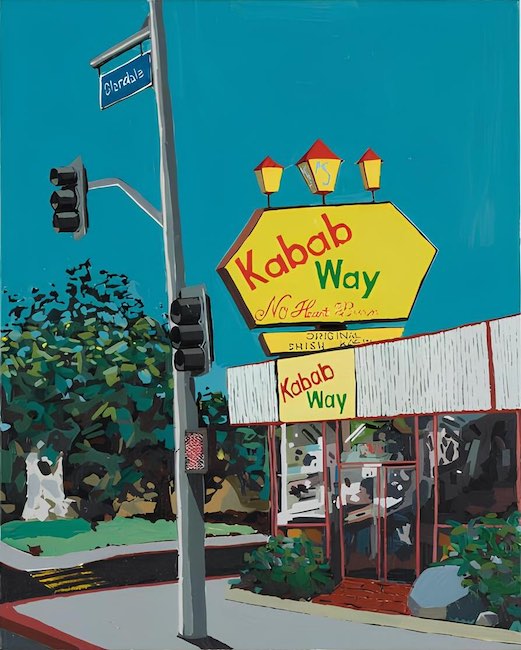
Ciò che affascina delle opere della Pecis è la capacità di condurre per mano il fruitore nel suo mondo, quello che costituisce la sua quotidianità ma anche quello che osserva ogni giorno intorno a sé, nella calda e solare Los Angeles dove le influenze di altre culture vicine è forte e incredibilmente visibile; questa caratteristica la avvicina a Frida Kahlo, sebbene in lei manchi la peculiarità della grande artista del Novecento di porsi costantemente al centro della scena, protagonista indiscussa di ogni opera. Hilary Pecis si mette al di fuori del campo visivo per raccontare con l’emozione della fanciulla tutto ciò che appartiene alla sua casa, ai suoi affetti, agli oggetti a cui non potrebbe mai rinunciare poiché costituiscono quelle sicurezze che generano un senso di appartenenza ma al tempo stesso di meraviglia, come se l’artista riuscisse ad apprezzarne ogni singolo particolare traendo gioia da esso anche in virtù della pittura.

La sua capacità di dare risalto alle piccole cose si associa però anche a uno sguardo più ampio, quello rivolto all’ambiente in cui vive, alla città che la ospita, a quegli scorci di strade immortalate nel momento di mancanza del traffico, e della presenza umana, volendo rendere assoluti protagonisti angoli da sempre sotto i suoi occhi e che le infondono una sensazione di pace e di serenità perché costituiscono un paesaggio conosciuto che la fa sentire a casa.
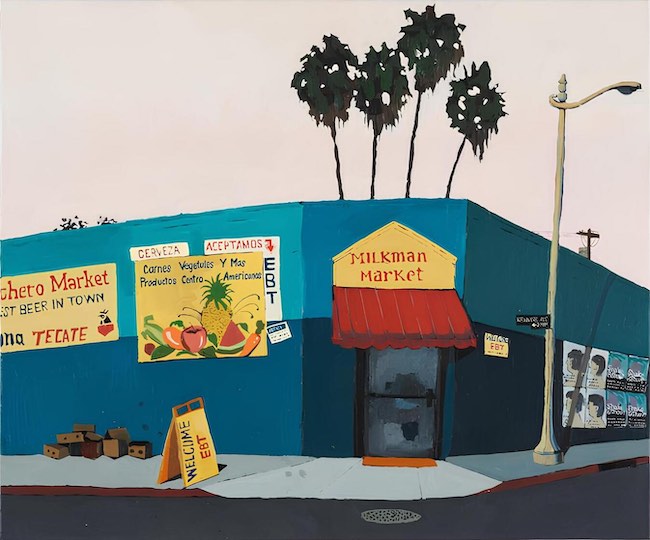
Questa è la sensazione che emerge dall’opera Beverly Market, un luogo familiare, un punto di riferimento della sua routine quotidiana di cui evidenzia tutto ciò che la colpisce: le insegne, le offerte del giorno, la promozione di quei prodotti che probabilmente ama acquistare. Colpisce l’assenza della figura umana che però è sottintesa perché senza di essa non vi sarebbero prodotti da vendere, non potrebbe restare aperto un locale senza avventori; tuttavia la Pecis desidera mettere in risalto l’edificio e il luogo in cui è collocato, l’immobilità di un mondo conosciuto come se per il tempo di un dipinto l’uomo potesse fare semplicemente da spettatore, perché in fondo è esattamente in sua assenza che è possibile cogliere tutti i dettagli da cui normalmente si è distratti.
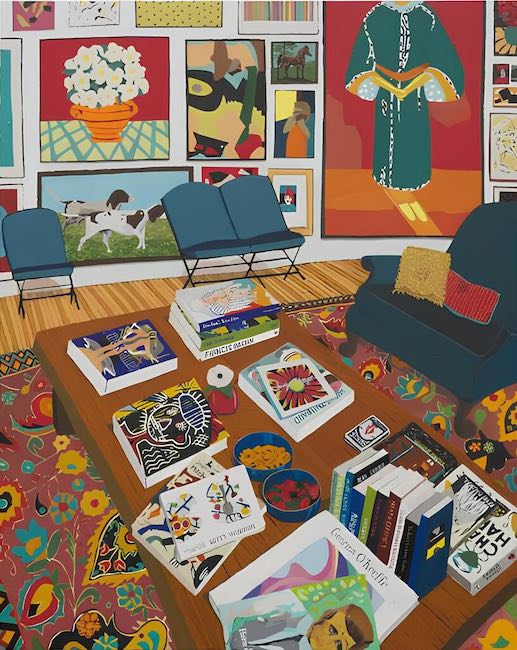
Il medesimo approccio analiticamente emotivo è presente in Interno con libri e dipinti, probabilmente una stanza del suo appartamento dedicata alla raccolta di quanto le è necessario per approfondire gli argomenti che le interessano, per ispirarsi agli artisti che considera dei riferimenti, come Georgia O’Keefe protagonista di un volume poggiato sulla scrivania; la dimensione intima dell’artista viene così svelata all’osservatore che entra volentieri in quel mondo fatto di oggetti, di opere d’arte eseguite da molti autori del passato più o meno recente, come se l’artista suggerisse che l’espressione pittorica non può non nutrirsi di tutto ciò che l’ha preceduta e a cui in qualche modo si è ispirata.
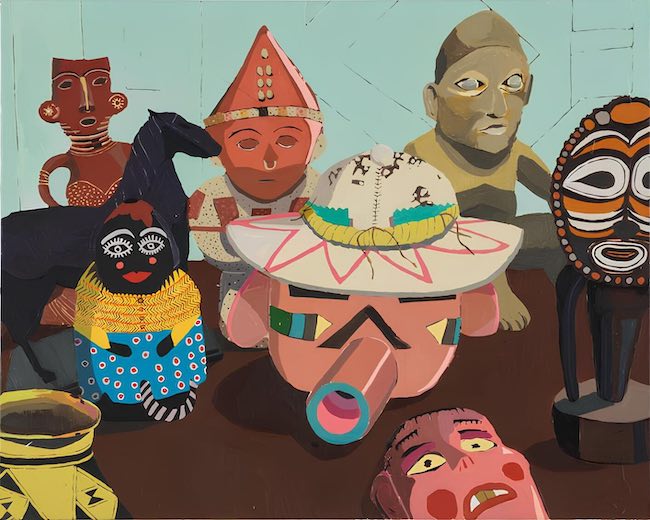
Ancora una volta gli oggetti sono protagonisti della tela Matt’s Collection in cui la Pecis ritrae una serie di teste e di maschere tribali di varie origini, africana, precolombiana, papuana, appartenenti a un uomo della sua cerchia familiare o di amicizie, questo non viene specificato, ma in ogni caso legato ai suoi affetti; la scelta di dedicare un dipinto a quegli oggetti corrisponde al desiderio dell’artista di mettere in risalto una peculiarità della persona a cui appartengono, un tratto caratteriale che ne sottolinea la curiosità, la sete di conoscenza nei confronti di tutto ciò che è antico e che è alla base della civiltà attuale. Gli oggetti incuriosiscono e inducono l’osservatore a mettere in gioco la propria cultura generale, la capacità di individuare il paese di originne di ciascuno di quei volti realizzati in vari materiali.
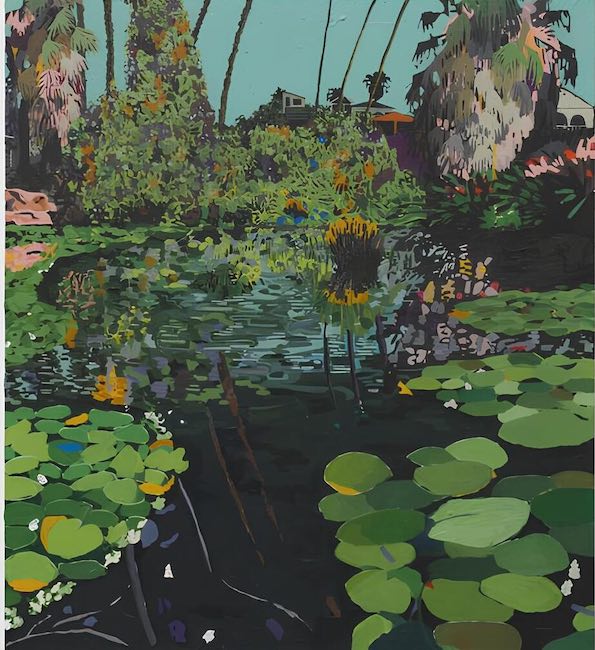
Quando però Hilary Pecis decide di immergersi nella natura svela tutto il suo lato poetico, ingenuo, spontaneo e che le permettere di arricchire le immagini immortalate del senso di pace e di tranquillità che appartiene alla sua indole e che costituisce il filtro con il quale contempla tutto ciò che la circonda; dunque in Echo Park Lake mette in risalto non solo lo specchio d’acqua su cui si muovono silenziose le ninfee bensì anche tutta la vegetazione circostante che sembra essere avvolta da un suggestivo silenzio, come se lo sguardo dell’artista avesse bisogno di distaccarsi da tutti i suoni che potrebbero distrarla dal suo stato equilibrato di pace, che è ampliato dalle tonalità intense e scure del verde. Hilary Pecis ha al suo attivo mostre personali a NY, Londra, Pechino, Sant’Agostino (Florida), Los Angeles, San Francisco, e le sue opere fanno parte di collezioni pubbliche e di musei di Porto Rico, Shanghai, Pechino, Hangzhou, Nanchino (Cina).
HILARY PECIS-BIOGRAFIA
Sito web: https://www.racheluffnergallery.com/artists/hilary-pecis
Facebook: https://www.facebook.com/hilarypecis
Instagram: https://www.instagram.com/hilary_pecis_art/
The Naïf world of Hilary Pecis, when reality needs to be dressed up as a fairy tale
Customs, traditions, everything that belongs to the known and sometimes personal and intimate world, have always been the subject and object of artistic representation, especially for those creatives who live immersed in their own reality made up of daily habits and certainties, but also of observation of the places and details that surround them. While some feel the need to narrate in a strongly realistic manner everything that their gaze rests on, others prefer to let themselves go to childish, imaginary, naive sensations, because their imagination needs to go beyond reality and immerse itself in the dimension of emotions, stylising and describing what they see as if they were in front of a fairy tale. The artist I am going to tell you about today chooses a style that is already linked to expressive simplicity to narrate everything that surrounds her and that belongs to her personal experience.
The end of the 19th century marked the beginning of that process of moving away from academic art that was destined to revolutionise history and the tastes of art lovers despite the resistance of the cultural circles that counted. Particularly in France, a courageous and visionary artist, Henri Rousseau, presented his artistic production at the Salon des Indépendents, characterised by a stylised pictorial stroke, evidently lacking any specific knowledge, through which he described an imaginary world of forests, ferocious beasts, dense vegetation and places he had never visited. It was precisely on that occasion that was born the Naïf style, in which the artists who adhered to it showed an inclination to describe poetic dimensions, immersed in an almost magical dimension in some cases, recounting everyday life with a different gaze, that of innocence.
The style took on different characteristics depending on the country of origin but also on the inclination of the individual artist, so that in Central Europe and in some Italian and French exponents it was characterised by landscapes seen in the distance inhabited by multitudes of small, almost miniaturised figures, as in the works of Zuzana Chapulova or Orneore Metelli and Louis Vivin; in other cases, however, the figures were larger, while remaining linked to the immediacy and simplicity of representation but also expression, as in part of the French production, of which Camille Bambois was an exponent in addition to Henri Rousseau, the Italian one with Antonio Ligabue, the South American with Fernando Botero and Tarsila do Amaral, not forgetting Frida Kahlo, somewhere between Naïf and Surrealism. Parallel to this type of artistic revolution, a stylistic innovation also emerged in the early 20th century that in its evolution somehow crossed its destiny with that of the Naïf movement, since it presented a similar chromatic and figurative approach with the added touch of the unreal given by a completely emotional interpretation of the observed; the Fauves group in fact placed colour at the centre of the artwork, as if it were the main actor capable of immediately communicating to the observer the sensation that the author of the work wanted to express. Not only that, some of these artists, such as Henri Matisse, described their world in a fairytale-like manner because after all, everyday reality could be interpreted with a less serious, less boring point of view, and therefore more attentive to all those details that are able to excite just by their constant presence.
The American artist Hilary Pecis, born in California and currently living in Los Angeles, combines the characteristics of the two painting styles just described to give life to a personal language through which she tells her world, the everyday life so dear to Matisse, emphasising it with a strong, intense, full colour palette devoid of nuances; on the other hand, however, the clean, defined stroke, as well as the tendency to reproduce reality with an imaginary touch, with a ingenuous simplicity that induces the observer to feel involved in that dimension precisely because of the immediacy of the message that leaves nothing to interpretation, cannot but lead her back to Naïf art of which she becomes an interesting contemporary voice. What is fascinating about Pecis‘ artworks is her ability to take the viewer by the hand into her world, the one that constitutes her daily life but also the one she observes each day around her, in the warm and sunny Los Angeles where the influences of other neighbouring cultures is strong and incredibly visible; this characteristic brings her close to Frida Kahlo, although she lacks the great 20th century artist’s peculiarity of constantly placing herself at the centre of the scene, the undisputed protagonist of each work. Hilary Pecis keeps herself outside the visual field in order to recount with the emotion of a maiden everything that belongs to her home, her affections, the objects she could never give up because they constitute those securities that generate a sense of belonging but at the same time of wonder, as if the artist were able to appreciate every single detail, drawing joy from it also by virtue of painting. However, her ability to emphasise small things is also associated with a broader gaze, that of the environment in which she lives, of the city that hosts her, of those glimpses of streets immortalised when there is no traffic, no human presence, wanting to make corners that have always been in front of her eyes the absolute protagonists and that infuse her with a feeling of peace and serenity because they constitute a familiar landscape that makes her feel at home.
This is the feeling that emerges from the artwork Beverly Market, a familiar place, a landmark in her daily routine of which she highlights everything that strikes her: the signs, the offers of the day, the promotion of those products she probably loves to buy. The absence of the human figure is striking, but it is implied, because without it there would be no products to sell, a shop could not remain open without clients; nevertheless Pecis wishes to emphasise the building and the place in which it is located, the immobility of a known world as if for the time of a painting man could simply act as a spectator, because after all it is precisely in its absence that it is possible to grasp all the details from which one is normally distracted. The same analytically emotive approach is present in Interior with books and paintings, probably a room in her flat dedicated to collecting what she needs to delve into the subjects that interest her, to be inspired by the artists she considers to be references, such as Georgia O’Keefe, protagonist of a volume resting on her desk; the intimate dimension of the artist is thus revealed to the observer, who willingly enters that world made up of objects, of works of art executed by many authors from the more or less recent past, as if the artist were suggesting that pictorial expression cannot but be nourished by all that has preceded it and by which it has in some way been inspired. Once again, objects are the protagonists of the canvas Matt’s Collection in which Pecis portrays a series of heads and tribal masks of various origins, African, pre-Columbian, Papuan, belonging to a man from her family circle or friendship, this is not specified, but in any case linked to her affections; the decision to dedicate a painting to those objects corresponds to the artist’s desire to highlight a peculiarity of the person to whom they belong, a character trait that underlines his curiosity, his thirst for knowledge about all that is ancient and at the basis of present-day civilisation. The objects arouse the viewer’s curiosity and induce him to bring into play his general culture, the ability to identify the country of origin of each of those faces made of various materials. However, when Hilary Pecis decides to immerse herself in nature, she reveals all her poetic, naive, spontaneous side, which allows her to enrich the immortalised images with the sense of peace and tranquillity that belongs to her nature and which constitutes the filter with which she contemplates everything around her; thus in Echo Park Lake she highlights not only the sheet of water on which the water lilies move silently, but also all the surrounding vegetation that seems to be enveloped in an evocative silence, as if the artist’s gaze needed to detach itself from all the sounds that could distract it from its balanced state of peace, which is amplified by the intense, dark tones of green. Hilary Pecis has solo exhibitions in NY, London, Beijing, St. Augustine (Florida), Los Angeles, San Francisco to her credit, and her works are part of public and museum collections in Puerto Rico, Shanghai, Beijing, Hangzhou, Nanjing (China).


